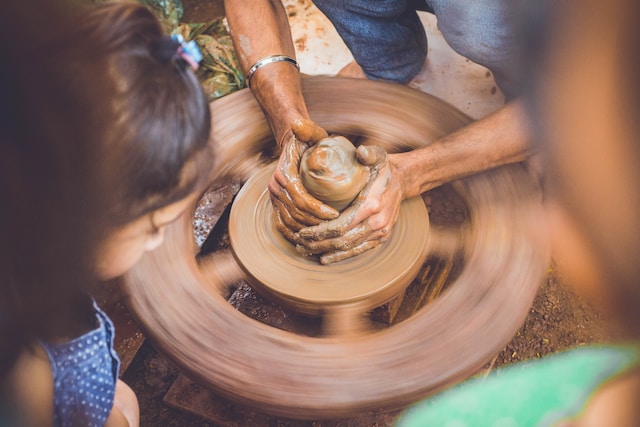Belize offers visitors a diverse array of arts and culture. Visitors will discover traditional paintings, wood carvings, baskets and embroidered textiles at gift shops or artisan stalls throughout the country.
You can purchase art in Belize City, Ambergris Caye and surrounding areas. Some of the most recognizable Belizean artists include Benjamin Nicholas, Carolyn Carr, Gilvano Swasey and Pen Cayetano.
Another popular choice among travelers is to purchase hand-woven Maya baskets and furniture from Jippi Jappa palm. These are produced by women who have mastered the skill of weaving using their bare hands and can be found in many souvenir shops and resort gift shops across the country.
Belize Traditional Arts & Crafts
Belizean culture has long been defined by an amalgamation of influences from indigenous Mayan populations, Caribbean islands and African slaves – as evidenced in the art, music and dance of this country. Traditional crafts remain an integral part of daily life in Belize – from home workshops to selling them at markets or shops.
Painting and woodcarving are among the most beloved arts in Belize, often depicting its beautiful natural environment and lifestyle in their works of art. Additionally, sculptures made out of various materials (particularly zericote wood) as well as engravings on slate or ceramic are common – basket and cloth weaving are two other popular Belizean arts & crafts as well.
Belize boasts traditional musical styles in the form of folk music and distilleries throughout the country producing its popular rum. Furthermore, Belizeans love dancing; you’ll find reggae, soca, calypso, punta and brukdown among its dance styles.
Culture in Belize not only values dance but also drama, song and poetry. Many public holidays in the country stem from its long and rich history and tradition – such as Mayan New Year celebrations, Carnival events or Miss Costa Maya pageants.
Sports are an integral component of Belizean culture. Football (soccer) is by far the most beloved activity, and a semi-professional league has been created here. Cycling, swimming and canoeing are other favorite recreational pursuits; annual canoe races take place to commemorate national holidays and commemorate these activities as well.
Belize’s majority population identifies with Christianity, with Roman Catholicism being the largest denomination. However, Garifuna and some Mayans follow different faiths; religious-based community work programs exist throughout Belize – though some shady church groups prey upon poor and vulnerable individuals to secure donations for themselves.
Zee Edgell is one of Belize’s best-known contemporary authors, best known for her novel Beka Lamb which chronicles Belize City’s emerging sense of nationalism in the 1950s. Her stories offer insight into Belize’s rich history and culture while providing an account of a Creole girl growing up during that period.
Preserving Belizean Traditions: Exploring Crafts
The Belize National Museum is committed to preserving its nation’s history and culture through educational programs. Visitors can explore a diverse selection of crafts and artwork at the museum to better immerse themselves in Belizean culture and understand how ancient traditions continue to shape its identity today.
Belize remains home to an active Maya culture, evidenced by their influence being felt from architecture like Sak Tunich to courting rituals among modern-day Garifuna people. Their presence can also be felt among Mestizo populations such as that of Belize City which include Mayans who are mixed between Spanish and Mayan origins, with more families choosing traditional Mayan ways of life than ever before. This population growth can also be found through immigration.
One example can be seen across Belizean villages where thatch houses made from cabbage palm leaves, wild cane, and straw plating are still widely used today in rural areas – testaments to how diverse Belize’s cultures truly are.
Other traditional crafts found throughout Belize today include pottery making, woodcarving and slate carving. Elders frequently teach these skills to younger generations so as to continue this vital art tradition of Belizean art. The Garcia sisters, for instance, are widely acclaimed for reviving slate carving as an art form and giving it back into prominence within Belizean art history.
Musical traditions in Barbados are also very prominent, particularly reggae and other Caribbean styles. You may also hear Latin instruments like xylophones and marimbas across different regions of the country. Additionally, you might encounter brukdown sounds which first emerged during timber workers used any object they could to create rhythm in the 1800s.
Make time in December to attend the annual Junkanou festival for an unforgettable experience. Witness masked dancers, primo and segundo drummers performing Wanaragua rhythm dances that you won’t soon forget! Don’t miss this beautiful and inspiring event!
Belize Cultural Tapestry: Traditional Arts
Like other Latin American nations that were colonized, Belize has experienced its share of difficulties over its long history. Yet it has proven itself remarkably resilient: for example, after being uprooted from their homeland in the Caribbean, Garifuna people battled hard to gain respect and dignity as part of Belizean culture, with their vibrant music being heard all across its territory.
Tourists traveling to Belize for its artistic traditions will likely be charmed. Paintings, wood carvings, baskets and embroidered textiles can all be found at gift shops and artisan stalls; while Belizeans utilize natural materials like conch shells, seeds and leaves from jippy-jappy plants to craft their pieces – even making jewelry out of lionfish fins to help protect its pristine barrier reef!
Other prominent Belizean crafts include straw platting, an intricate weaving technique used for creating wicker furniture and baskets and earthenware pots and jars. Garifuna woodworkers excel in carving intricate canoes and boats from local zericote wood – something African slaves introduced into this region of the world, and which continues to thrive today in Belize.
Numerous museums and institutions highlight Belizean culture. The Museum of Belize, housed in what used to be Her Majesty’s Prison, presents three millennia of Mayan history and displays from diverse ethnic groups of Belize. Meanwhile, in Belize City there’s the House of Culture which acts as another venue for artistic expression with workshops, seminars, and other events highlighting Belize’s rich heritage.
Other cultural centers of note in Belize include the Bliss Center for Performing Arts and Belize Centre for Art Education. Meanwhile, the National Institute of Culture and Arts provides oversight over an array of cultural activities from reenactments to protecting ancient artifacts.
Belize’s landscape is packed with breathtaking natural wonders. Enjoy floating through Moho River’s whitewater while admiring stalactites and stalagmites; or take to zip lining above a rainforest canopy! Cayo District’s pristine rainforest boasts hundreds of bird species as well as an abundance of reptiles and amphibians – perfect places to discover Belize!
Celebrating Belize’s Crafts: Past to Present
Belizean artisans create work in diverse styles and materials. These include folk artists who continue traditional craft making in their communities as well as modern painters, sculptors and ceramicists who produce beautiful representational and abstract works exhibited at government Houses of Culture or private galleries in Belize City, San Pedro or other towns and cities.
The Cayo district of western Belize is home to many talented Mayan artisans who continue the ancient art form of carving slate bas-reliefs, like those offered by the Garcia sisters of Tanah (Mayan for San Antonio) village in Western Cayo district. These sisters also make a living carving wood furniture for sale and maintain a small museum dedicated to this form.
Colonial architecture remains in some buildings that have been well preserved over time, while many others have been destroyed by fires or hurricanes over time. Clapboard houses with pastel colors lining coastal and caye areas remain as examples of colonial heritage.
Traditional Belizean dishes remain immensely popular, from seafood and fruit dishes to cacao produced in several Belizean communities, and available as local chocolate bars from numerous chocolatiers. Belizean rum is another must-try – its distilleries produce both white and dark varieties for you to sample!
For an authentic glimpse of history, nothing beats exploring one of Belize’s renowned ruins – from Mayan pyramids at Caracol and Xunantich to lesser sites scattered throughout. Additionally, Belize boasts numerous caves perfect for exploration either on foot or kayak.
Belize is well known for its cuisine. Visitors can sample an eclectic array of traditional and international cuisine in restaurants across the country, while there are also several outstanding coffee shops serving 100% organic shade grown coffee brewed to perfection. A cup can be enjoyed alongside delicious slices of cake or bowls of hearty soup – an experience not to be missed!




